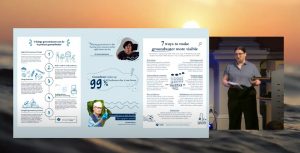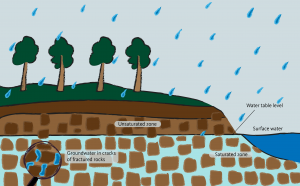- SIWI – Leading expert in water governance
- /
- Latest
- /
- 7 ways to make groundwater visible
7 ways to make groundwater visible
 What is beneath our feet? Being underground makes groundwater almost “mysterious”. Image credit: Shutterstock/enhanced illustration by SIWI
What is beneath our feet? Being underground makes groundwater almost “mysterious”. Image credit: Shutterstock/enhanced illustration by SIWI Groundwater is often referred to as an ‘invisible resource’. Hiding under our feet, it is impossible to tell its presence which affects the way it is used and this common resource is shared between communities and across borders.
Through this article, Dr Jenny Grönwall calls upon all communicators to collaborate with experts and vice versa, to take on the responsibility and use their creativity to make the invisible groundwater visible. Increased awareness and knowledge sharing can inform the need to restore aquifers, the reservoirs of groundwater, and promote sustainable use of groundwater.
Here are 7 ways to make groundwater more visible:
1. Demystifying
Being underground makes groundwater seem “mysterious”. What we can see is the infrastructure needed to extract it. Groundwater is not a flowing river, but water that exists in cracks, pores and fractures. Better visualisations can help to demystify and bust some common myths. For example, what does polluted groundwater look like? Groundwater is not always “pure” and can be unfit for drinking due to presence of naturally occurring arsenic, which is impossible to see or photograph.
2.Understanding the complexity
Groundwater is the resource, and the aquifer its “host” -both of which need to be protected. The hydrological cycle is only one of the factors that affects how quickly water is recharged after extraction. Contaminated groundwater can take a long time to remediate. Understanding such complex processes can help us to value this invisible resource.
3. Getting data on ‘hidden’ use
Lack of understanding and data on who uses how much groundwater for what and at which time is missing in most countries. Unknown individual usage and access means that not all water resources are accounted during planning and management. The same is true for aquifers which are shared across borders, exacerbating the risk of power asymmetries.
4. Assessing the impact of climate change
Climate change is a silent threat to groundwater quality and quantity, and very little is known about its future impacts. Extreme rainfall caused by climate change cannot infiltrate the ground and rejuvenate aquifers. High temperatures increase evaporation and decreases recharge.
5. Unlocking potential
Harvesting rainwater and investing in structures that enhance aquifer recharge can help to make groundwater use sustainable and improve food security, human health and aquatic biodiversity. This is not only important for regions that have seasonal rain periods, but a way of looking at the underground reservoirs as “banks” that can be used as buffers for dry days.
6. Highlighting its role for biodiversity
Groundwater is not just for human use but is integral to maintaining streamflow and supporting ecosystems such as wetlands. Over-pumping is already driving biodiversity loss and degrading of groundwater-dependent ecosystems. Making such connections will go a long way in making groundwater visible, and understanding the need to protect aquifers.
7. Joining hands
Multiple disciplines need to come together to shine the light on groundwater. We need all perspectives and different disciplines – the social scientists, the lawyers, the modellers, and the engineers to pull all the knowledge, and for communicators to make groundwater visible.
The 2022 theme for World Water Day, set by UN Water, is Groundwater
Make groundwater visible
Download the illustrated version of those 7 ways to make groundwater visible
Get the listGet to know Groundwater
Groundwater has been out of sight and out of mind for too long. When we protect groundwater we save lives and ecosystems, improve health, reduce hunger and tackle climate change all at once.
Learn more








